As dedicated rose gardeners, we know the pain of seeing our roses get sick. These flowers add so much beauty and joy to our lives. That’s why keeping them healthy is crucial.
In this guide, we’ll cover the common rose diseases. We’ll give you the knowledge and tools to spot, treat, and stop these diseases from harming your garden.
Key Takeaways
- Familiarize yourself with the most prevalent rose diseases, including fungal, bacterial, and viral infections.
- Learn to recognize early warning signs and symptoms to enable prompt intervention.
- Discover effective treatment options, both chemical and organic, to restore the health of your roses.
- Understand the importance of preventative measures, such as proper pruning, watering, and cultivating disease-resistant varieties.
- Explore the benefits of an Integrated Pest Management (IPM) approach for sustainable rose care.
Understanding Common Rose Diseases
We love our roses and want them to stay healthy. Unfortunately, they can get sick from fungi, bacteria, and viruses. Spotting problems early and treating them right is key to a beautiful garden.
Overview of Rose Health Issues
Roses often face fungal diseases like black spot and powdery mildew. These can make leaves fall off and weaken the plant. Bacterial infections, like crown gall, can also harm the plant, causing growths.
Importance of Early Detection
It’s important to catch rose diseases early. Signs like spots, discoloration, and wilting mean something’s wrong. By checking our roses often and acting fast, we can stop diseases from spreading.
“Vigilance and a proactive approach are essential in maintaining healthy, thriving rose plants.”
Watching over our roses and fixing problems quickly helps them stay healthy. Let’s all do our part to keep our gardens beautiful and our roses thriving.
Fungal Diseases of Roses
Roses can get sick from many fungal diseases. These can hurt their health and look. The most common ones are powdery mildew, black spot, and downy mildew. Knowing how to treat these diseases is key to keeping our roses healthy.
Powdery Mildew: Identification and Photos
Powdery mildew looks like a white, powdery stuff on rose leaves and buds. It loves warm, dry places and spreads fast. It can make plants weak and drop leaves. Spotting it early and treating it quickly is very important.
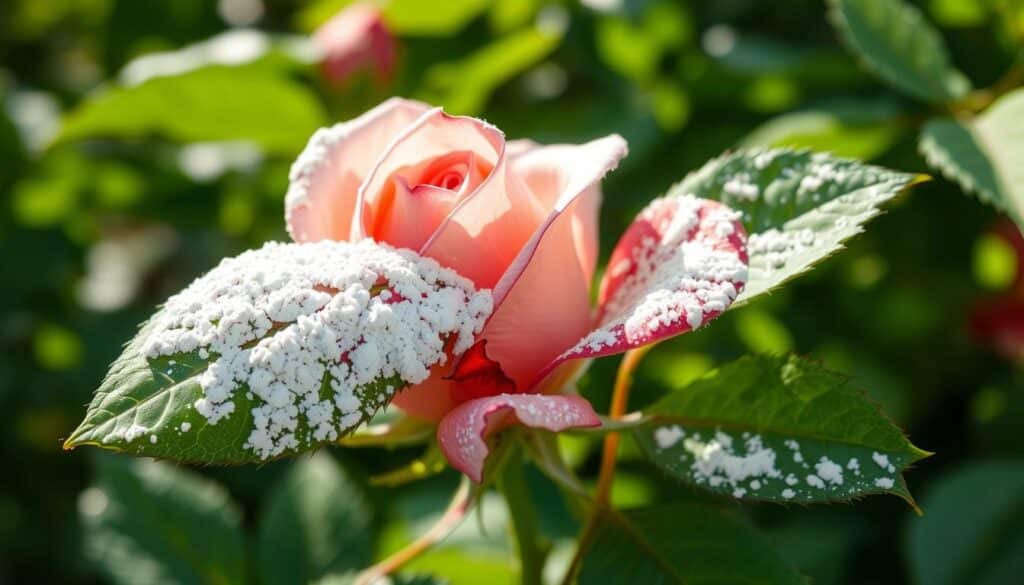
Black Spot: Symptoms and Treatments
Black spot is a big problem for roses. It shows up as black spots with yellow edges on leaves. These spots can grow together and harm the plant. To fight it, we need to prune, keep things clean, and use special sprays.
Downy Mildew: Causes and Control
Downy mildew likes cool, wet places. It makes brown or purple spots on leaves that can fall off. To stop it, we need to keep air moving, water plants right, and use the right sprays.
Stopping these diseases takes a few steps. We need to prevent them, find them early, and treat them right. By knowing how to handle each disease, we can keep our roses looking great all season.
Bacterial Diseases Affecting Roses
Roses can get sick from different bacterial diseases. Two common ones are bacterial canker and crown gall. Knowing about these and how to stop and treat them is key to keeping our roses healthy and looking good.
Bacterial Canker: Understanding the Problem
Bacterial canker is a serious disease that can harm rose plants a lot. It shows up as discolored, sunken spots on the stems, which can cause the plant to die back. This disease is caused by Pseudomonas syringae and likes cool, wet weather.
Crown Gall: Identification and Management
Crown gall is another disease that affects roses. It looks like big, bumpy growths near the base or roots of the plant. It’s caused by Agrobacterium tumefaciens and can live in the soil for up to 3 years. It’s important to act fast to stop it from spreading.
There’s no good chemical way to fight these diseases in roses. The best thing to do is prevent them by taking good care of your rose plants. This means avoiding damage to the plant, using healthy plants, and removing any sick parts right away.
| Disease | Cause | Symptoms | Management |
|---|---|---|---|
| Bacterial Canker | Pseudomonas syringae | Discolored, sunken areas on stems, dieback | Removal of infected plant parts, avoiding wounding, using disease-free planting material |
| Crown Gall | Agrobacterium tumefaciens | Large, bumpy growths near the base or roots | Removal of infected plant parts, avoiding wounding, using disease-free planting material |
By knowing about these diseases and taking steps to prevent and manage them, we can keep our rose plants healthy and strong for a long time.
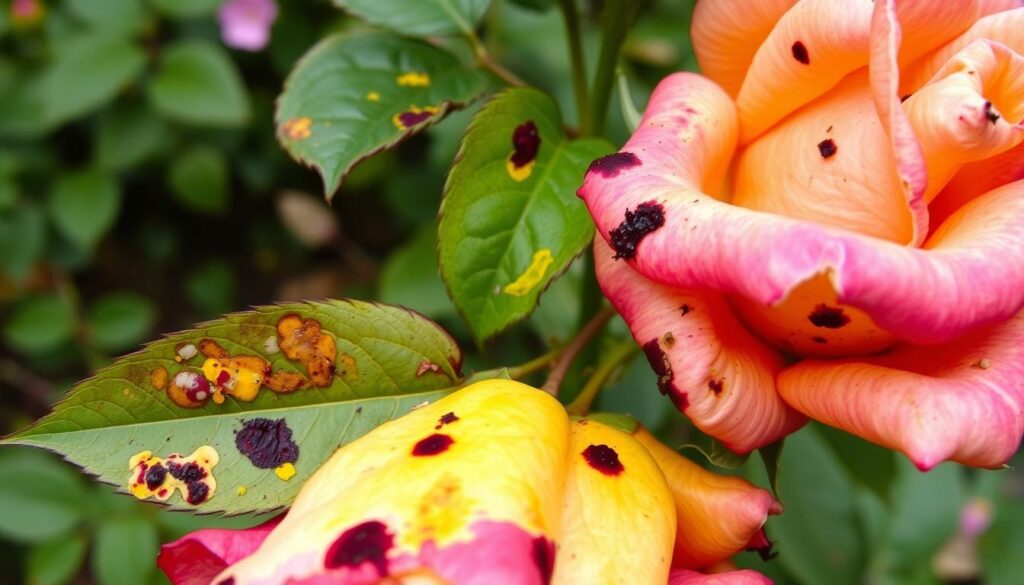
“The best defense against bacterial diseases in roses is prevention through proper plant care and vigilance in identifying and addressing any issues as early as possible.”
Viral Infections in Roses
Viral infections can be a big problem for rose growers and fans. The rose mosaic virus and the rose rosette virus are two common diseases. Knowing how to spot and prevent these viruses is key to keeping our rose plants healthy.
Rose Mosaic Virus: Symptoms and Prevention
The rose mosaic virus shows up as yellow lines or mottling on leaves. It can make plants weaker, reduce flowers, and make them more likely to die in winter. Sadly, there’s no cure for infected plants, and no resistant rose varieties.
To fight rose mosaic virus, start with clean plants and use heat to grow disease-free ones. Watch your plants closely and remove any that get sick. This helps stop the virus from spreading.
Other Common Viral Diseases
- Rose Rosette Virus (RRV): This virus causes weird growth, too many thorns, and bad flowers. RRV spreads through mites and can kill plants in 2-4 years.
- Rose Yellow Mosaic Virus (RoYMV): It shows up as mosaic patterns on leaves. This virus is spread by aphids and weakens plants.
Since viral diseases in roses can’t be cured, stopping them before they start is vital. Use virus-free plants, control bugs, and remove sick plants fast. This keeps our rose gardens healthy.
| Viral Disease | Symptoms | Transmission | Management |
|---|---|---|---|
| Rose Mosaic Virus | Yellow line patterns, mottling on leaves | Grafting, budding | Heat therapy, virus-free stock |
| Rose Rosette Virus | Abnormal growth, excessive thorns, distorted flowers | Eriophyid mites | Mite control, removal of infected plants |
| Rose Yellow Mosaic Virus | Mosaic patterns on leaves | Aphids | Aphid control, virus-free stock |
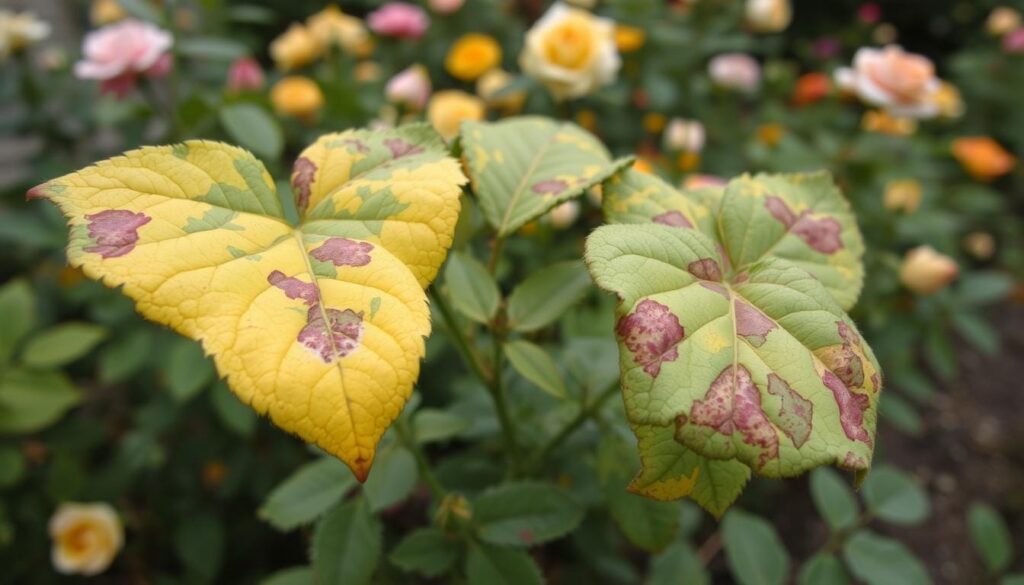
Knowing about viral diseases in roses helps us protect our gardens. Being careful and using all prevention methods keeps our roses healthy and beautiful. Let’s make sure our roses stay vibrant for many years.
Environmental Factors and Rose Diseases
To keep rose gardens healthy, we need to understand the environmental factors that affect plant health. Weather and soil quality are key. These elements help prevent and manage rose diseases. By focusing on these areas, we can help our rose bushes thrive and lower disease risks.
How Weather Affects Plant Health
Roses are sensitive to weather changes. High humidity and poor air circulation can lead to fungal diseases like powdery mildew and black spot. On the other hand, extreme temperatures and drought can weaken plants, making them more vulnerable to diseases. Knowing how weather impacts rose health helps us take steps to protect our gardens.
Soil Quality and Its Impact on Disease
Soil quality is crucial for rose health and disease resistance. Good soil preparation, including organic matter and proper drainage, is essential. It helps maintain nutrient balance and prevents waterlogging, which can cause root rot. Improving soil quality is key to preventing rose diseases.
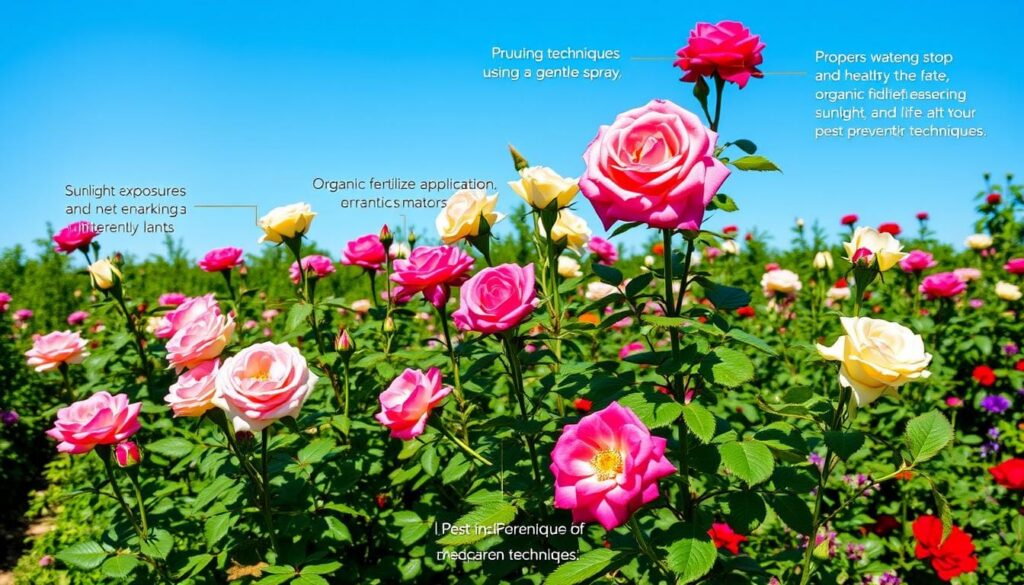
“Understanding the environmental factors that contribute to rose diseases is the first step in effectively preventing and managing these issues in our gardens.”
By monitoring weather, air circulation, and soil conditions, we can create a healthy environment for our rose plants. This approach helps reduce disease risks and ensures the success of our rose care efforts.
Pests That Cause Disease in Roses
Keeping roses healthy and vibrant requires managing pests. Aphids and spider mites are two common pests that can harm roses. Knowing how to identify and manage them is key to keeping your roses in top shape.
Aphids: Identification and Management
Aphids, or greenfly, are small, soft insects that live in colonies on new rose growth. They suck sap, causing leaves and flowers to become distorted. They can also spread plant viruses. To fight aphids, try using beneficial insects or sprays like insecticidal soap or neem oil.
Spider Mites: Symptoms and Treatment
Spider mites are tiny, eight-legged pests that harm rose leaves. They cause stippling, bronzing, and leaf drop. Spotting them early is crucial to prevent damage. Use water sprays or a miticide specifically for roses to control them.
Watching for these pests and acting fast can prevent disease and damage. By tackling these problems quickly, your roses will stay healthy and beautiful all season.
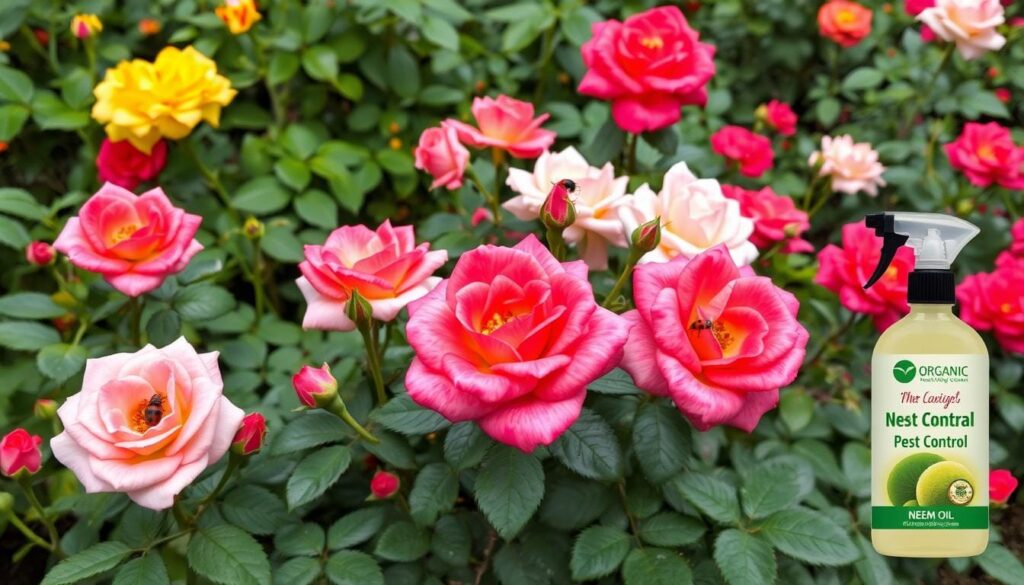
Nutrient Deficiencies and Their Impact
Keeping our rose plants healthy is key. We must understand how nutrient deficiencies affect them. These imbalances can weaken roses, making them more vulnerable to diseases and pests. By spotting these signs early, we can fix the issues and keep our roses thriving.
Signs of Nutrient Deficiencies
Nitrogen and iron deficiencies can cause yellow leaves and leaf discoloration. Magnesium deficiency also leads to leaf color changes. Regular soil tests and plant checks help us catch these problems early.
Treatment Options for Healthy Roses
For healthy roses, the right nutrients are essential. We can use organic or synthetic fertilizers to balance them. Balanced fertilizers or targeted supplements help fix specific issues. Mulching and proper watering also boost plant health.
By being proactive and addressing nutrient issues quickly, we can keep our rose gardens healthy. Regular checks and care are vital for a successful garden.
“Proper soil testing and balanced fertilization can prevent nutrient deficiencies and promote overall plant health.”
Techniques for Preventing Rose Diseases
To keep your rose garden healthy, you need to take care of it every day. Proper watering and regular pruning are key. These steps help prevent diseases from taking over.
Proper Watering Practices
Watering your roses right is vital for their health. Water at the base, not on the leaves. This stops fungal diseases like powdery mildew and black spot. Water deeply but not too often, letting the soil dry a bit between waterings.
Importance of Pruning and Maintenance
Pruning is a must for keeping roses disease-free. It boosts air flow and helps fight off fungi. Remove any sick or damaged parts quickly. Also, keep plants apart and clean up leaves and debris to keep your garden healthy.
| Rose Care Technique | Benefits for Disease Prevention |
|---|---|
| Proper Watering | Reduces risk of fungal diseases by keeping foliage dry |
| Regular Pruning | Improves air circulation and removes infected plant parts |
| Maintaining Spacing | Enhances air flow and prevents disease transmission between plants |
| Cleaning Up Debris | Eliminates potential sources of disease inoculum |
Using these rose disease prevention methods, rose care tips, and rose gardening techniques will make your garden thrive. You’ll enjoy beautiful, healthy roses all year round with less effort.
Integrated Pest Management (IPM)
We all want our rose bushes to look great and stay healthy. Integrated Pest Management (IPM) is a smart way to do this. It’s a green method that uses many techniques to keep our roses safe and healthy.
What is IPM?
IPM is a way to manage pests and diseases in a natural way. It uses plants that can fight off diseases, attracts good bugs, and follows good gardening practices. It also uses pesticides only when really needed.
Benefits of Using IPM for Roses
- It cuts down on the use of harsh chemicals, making rose care better for the planet.
- It helps roses stay strong and healthy, fighting off diseases and pests better.
- It helps control problems like powdery mildew, black spot, and aphids, keeping your garden looking good.
- It saves money in the long run by fixing problems at the source, not just treating them.
- It encourages good bugs like ladybugs and lacewings to help control pests naturally.
Using IPM lets us have beautiful, thriving rose gardens. It’s a way to care for our roses in a way that’s good for them and the environment. This approach helps us take care of our roses for a long time, making our gardens even more beautiful.
Effective Treatment Options for Rose Diseases
As rose lovers, we know how crucial it is to keep our roses healthy. We have many ways to treat rose diseases, including chemical and organic methods. Let’s look at the good and bad of each to help you choose the best for your garden.
Chemical Treatments: Overview and Safety
Chemical fungicides can fight off serious rose diseases like powdery mildew and black spot. They contain ingredients like chlorothalonil and propiconazole. But, it’s important to use them as directed and be careful when handling them.
Organic Treatments: Benefits and Methods
If you prefer organic care, there are many natural options. Neem oil and sulfur-based products are great for minor fungal issues. These choices are better for the environment and can be a good option for those who want to use fewer chemicals.
Remember, safety is key, no matter the treatment. Always follow the instructions to protect your roses and the environment.
“The best approach to rose disease management is to adopt a comprehensive strategy that combines preventive measures, early detection, and targeted treatment when necessary.”
Knowing about different treatments helps you make smart choices. This way, your roses can stay healthy and beautiful for many years.
Importance of Choosing Disease-Resistant Varieties
Choosing disease-resistant roses is key to keeping them healthy and vibrant. These roses need less chemical treatment and are perfect for easy gardens. By picking disease-resistant roses, we save time and money on common rose problems. This lets us enjoy our roses with less effort.
Recommended Disease-Resistant Rose Varieties
‘Knock Out’ roses are great because they fight off black spot well. ‘Carefree Beauty’ is also a top choice for its disease resistance and steady blooms. These and other varieties are bred to fight off many common rose diseases.
Advantages of Resistant Plants
- Reduced need for chemical treatments: Disease-resistant roses are less likely to get sick, so we use fewer harmful chemicals.
- Healthier, longer-lasting plants: These roses stay strong and bloom well for years, giving us beautiful flowers season after season.
- Lower maintenance: With disease-resistant roses, we spend less time fighting diseases and more time enjoying our garden.
- Improved aesthetic appeal: Healthy roses look great, with bright leaves and beautiful flowers, making our garden more beautiful.
Choosing disease-resistant roses is smart for gardeners. It helps us have a beautiful, easy-to-care-for rose garden that saves us time and money.
Recognizing Symptoms and Taking Action
Spotting rose disease symptoms early is key to keeping your plants healthy. Regular checks can help you catch problems early. Look for signs like leaf spots, wilting, color changes, and odd growth.
Common Symptoms to Look For
- Leaf Spots: Watch for discolored or twisted leaves. This could mean fungal diseases like black spot or powdery mildew.
- Wilting: Wilting plants might have bacterial infections, pests, or lack nutrients.
- Discoloration: Yellow, red, or purple leaves could mean nutrient issues or viral diseases like rose mosaic virus.
- Abnormal Growth: Stunted or twisted growth often points to pests or stress.
Regular checks and quick action are vital for your rose garden’s health. If problems persist, it’s time to get expert advice.
When to Seek Professional Help
If home remedies don’t work and symptoms get worse, seek a pro. A rose health diagnosis from a horticulturist or local office can help. They’ll offer professional rose care to fix the issue.
“Prevention is always better than cure when it comes to rose diseases. Stay vigilant and act quickly to maintain the health and beauty of your rose garden.”
Conclusion: Keeping Our Roses Healthy
Understanding the diseases that can harm our roses is key to keeping them healthy. We must tackle fungal, bacterial, and viral infections head-on. Environmental factors and pests also play a big role.
Prevention and early action are the best ways to fight these issues. This way, our rose gardens can thrive and bring joy for years.
Recap of Key Points
Choosing the right rose varieties is important. So is proper pruning and watering. Using integrated pest management (IPM) is also crucial.
By watching for disease signs early and acting fast, we can protect our roses. This ensures they stay healthy and beautiful for us to enjoy.
Encouragement for Continuous Learning
Gardening is a never-ending adventure, especially when it comes to roses. New pests and diseases pop up, and research finds new ways to fight them.
It’s vital for us to keep learning and trying new things. By sharing our knowledge and experiences, we help everyone grow better roses. This makes rose gardening better for all of us.

